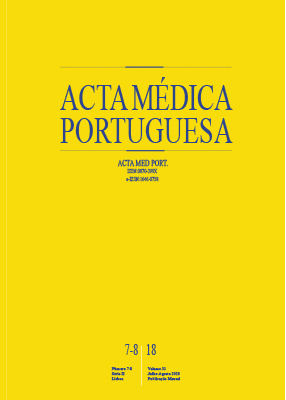Gestational Diabetes Mellitus: Is There an Advantage in Using the Current Diagnostic Criteria?
DOI:
https://doi.org/10.20344/amp.10135Keywords:
Diabetes, Gestational/diagnosis, Gestational/epidemiology, PortugalAbstract
Introduction: There is no international consensus regarding gestational diabetes mellitus diagnostic criteria. In Portugal, the Carpenter and Coustan criteria were replaced by an adaptation of the International Association of Diabetes and Pregnancy Study Groups criteria. Our aim was to compare the incidence and outcomes of pregnancies complicated by gestational diabetes mellitus according to the current and previous criteria.
Material and Methods: Retrospective analysis of 1218 singleton pregnancies complicated with gestational diabetes mellitus, with surveillance/delivery between 2008-2015. Two groups were considered: identification according to the Directorate-General of Health criteria - International Association of Diabetes and Pregnancy Study Groups (group 1); identification through Carpenter and Coustan criteria (group 2). A comparative analysis was performed.
Results: The incidence of gestational diabetes mellitus doubled (9.4% vs 4.6%), and the number of consultations/year increased (~3000 vs ~2000). In Group 1, in comparison with group 2, there was a lower risk of macrosomia in newborns [RR 0.44 (IC (95%):0.26 - 0.76)] and a higher risk of small for gestational age infants [RR 1.99 (IC (95%):1.19 - 3.31)]; a 6 - fold and 4 fold higher risk in neonatal hypoglycemia [RR 6.30 (IC (95%): 3.39 - 11.71)] and hyperbilirubinemia [RR 3.89 (IC (95%): 2.25 - 6.72)] were also observed, respectively. There were no differences regarding other outcomes.
Discussion: Outcomes related to the decrease in macrosomia did now show any improvement, with even an increase in Small for Gestational Age and neonatal complications. Given the increased incidence of gestational diabetes mellitus, Directorate-General of Health – International Association of Diabetes and Pregnancy Study Groups criteria may be associated with greater healthcare-related costs due to more frequent consultations, with no apparent obstetrical/neonatal benefit.
Conclusion: The Directorate-General of Health – International Association of Diabetes and Pregnancy Study Groups criteria were associated with a decrease in macrosomia, not accompanied by an improvement of obstetrical/perinatal outcomes. The benefit of using these criteria is open to debate.
Downloads
Downloads
Published
How to Cite
Issue
Section
License
All the articles published in the AMP are open access and comply with the requirements of funding agencies or academic institutions. The AMP is governed by the terms of the Creative Commons ‘Attribution – Non-Commercial Use - (CC-BY-NC)’ license, regarding the use by third parties.
It is the author’s responsibility to obtain approval for the reproduction of figures, tables, etc. from other publications.
Upon acceptance of an article for publication, the authors will be asked to complete the ICMJE “Copyright Liability and Copyright Sharing Statement “(http://www.actamedicaportuguesa.com/info/AMP-NormasPublicacao.pdf) and the “Declaration of Potential Conflicts of Interest” (http:// www.icmje.org/conflicts-of-interest). An e-mail will be sent to the corresponding author to acknowledge receipt of the manuscript.
After publication, the authors are authorised to make their articles available in repositories of their institutions of origin, as long as they always mention where they were published and according to the Creative Commons license.









